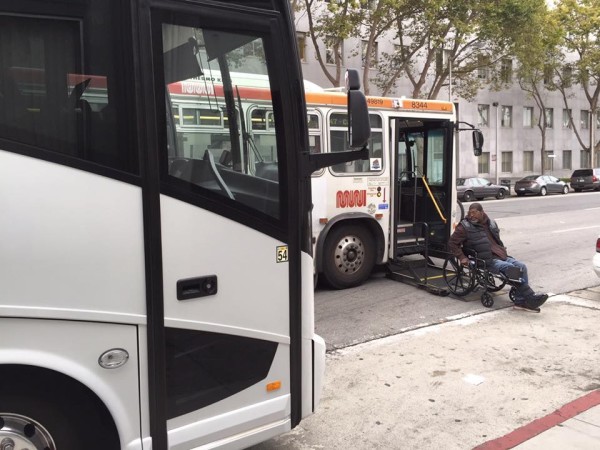
San Francisco transit planners have been working for years on a proposal to create bus-only lanes on Geary Boulevard. It’s called Bus Rapid Transit, and the idea is that – since we (unfortunately) don’t have a subway line underneath the Geary corridor, we can do the next best thing by creating lanes just for Muni.
Time the traffic signals right, keep cars out of the way of buses, and people can ride faster from the Richmond and the Western Addition to downtown.

The plan comes up for discussion at the MTA’s meeting Tuesday/21 – and there’s a twist.
Activists have discovered that Muni’s current proposal would allow not only Muni buses but private shuttles, like Chariot and the Google buses – to use the city’s public transit-only lanes.
Environmentalist and transit advocate Sue Vaughan (who has also written for 48hills) asked at an MTC Citizens Advisory Committee meeting in July whether private shuttles would be allowed to use the BRT lanes. MTC staff didn’t have an answer at that point – but a series of follow-up emails obtained by Vaughan show that the department believes under current rules, any private company that runs a bus with a capacity of more than ten people (including the driver) would count as “transit” and would be allowed on what were originally described as Muni-only lanes.
Joe Fitzgerald Rodriguez first broke this story Aug. 19 in the Examiner.
A July 26 memo from Liz Brisson, major corridors manager for the Sustainable Streets Division, which Vaughan shared with me, states that
commuter shuttles or private transit vehicles such as Chariot would be allowed to use the lanes if using vehicles designed, used, or maintained for carrying more than 10 persons.
That’s a big deal. It’s as if the city said that anyone who could afford a private train car could run it on the Muni Metro tracks.
Help us save local journalism!
Every tax-deductible donation helps us grow to cover the issues that mean the most to our community. Become a 48 Hills Hero and support the only daily progressive news source in the Bay Area.
And, of course, the Google Buses and the Chariot shuttles are going to do exactly what BRT was meant to avoid: Slow down Muni.
The entire BRT project is up for discussion at the MTA meeting, and while the private shuttle issue isn’t specifically on the agenda, I’m sure it will come up in public comment.
“The SFCTA and SFMTA have been working on this project for at least 15 years, dating back to the passage of Prop K in 2003, the sales tax that set aside funds for Geary LRT studies among other projects,” said Vaughan. “As the project has developed, It has always been the public understanding that Geary BRT, from the avenues to Van Ness, would be for public buses only. And we demand that dedicated lanes along Geary from Stanyan to Gough remain that way.”
Vaughan added:
The environmental impact report did not analyze the impact of private, for-profit buses (which includes casino buses, tour buses, and Academy of Art University buses, as well as Chariots, tech shuttle buses, and perhaps future Uber or Lyft buses) on the flow of Muni. And it certainly didn’t ask the question. Not one Geary Rapid Diagram has ever depicted a Chariot or a tech shuttle bus in a red lane.
Of added concern is the fact that there are no limits on the number of Chariots, tech shuttle buses, casino buses, or tour buses that can be in operation in the city. As of February 2018, there were 996 commuter shuttles with placards, although there are not necessarily that many in operation at once during commute hours. (That’s more than the city’s entire fleet of rubber tire vehicles, and the tech shuttles only run during commute hours and only along certain routes as of now.) I don’t know how many Chariots, casino buses, tour buses, or other vehicles that fit the definition of a bus are in operation in San Francisco now. How is Muni going to be able to expand to meet the needs of a growing population and to combat climate change if it’s competing for lane space with other vehicles? And why isn’t the SFMTA planning to charge for access to dedicated lanes?
The meeting’s at 1pm in Room 400, City Hall. If you can’t make it and want to comment, you can email MTABoard@SFMTA.com with subject line “Geary Rapid Project.”
